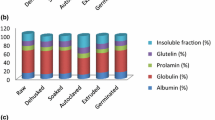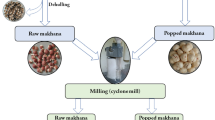Abstract
The present study was aimed to evaluate the differences among anti-nutritional factors in relation to mineral absorption and protein digestibility of Easy-to-cook (ETC) and Hard-to-cook (HTC) grains from different kidney bean (KB) accessions.HTC grains showed lower a* (redness to yellowness) and b* (greenness to blueness) values and L* value than ETC grains. HTC grains had significantly higher Ca and Zn and lower Cu, Mn and Fe than ETC grains. ETC and HTC grains showed significant variation in mineral, total phenolic content (TPC), tannin and phytic acid content. TPC and tannin content were significantly higher for HTC grains, on the contrary phytic acid content was lower than counterpart ETC grains. Protein and in vitro protein digestibility (IVPD) also varied significantly between HTC and ETC grains and was found to be lower for HTC grains. Majority of phenolic compounds (PCs) were present in bound state in both ETC and HTC grains. Moreover, HTC grains showed higher amount of chlorogenic acid and catechin content than ETC grains in bound form. ETC and HTC grains from dark color accessions showed higher catechin content.

Similar content being viewed by others
References
AACC International. Approved methods of analysis, 11th (ed.) Method46-13.01.Crude protein-Micro-Kjeldahl method. Approved October 8, 1976; reapproved November 3, 1999. AACC International: St. Paul,MN. http://dx.doi.org/10.1094/AACCIntMethod-46-13.01
Akeson WR, Stahmanna AA (1964) Pepsin pancreatin digest index of protein. J Nutri 83:257–261
Akond ASMGM, Crawford H, Berthold J, Talukder ZI, Hossain K (2011) Minerals (Zn, Fe, Ca and Mg) and antinutrient (phytic acid) constituents in common beans. Am J Food Technol 6:235–243
Beebe S, Gonzalez AV, Rengifo J (2000) Research on trace minerals in the common bean. Food Nutri Bull 21:387–391
Beninger CW, Hosfield GL (2003) Antioxidant activity of extracts, condensed tannin fractions, and pure flavonoids from Phaseolus vulgaris L. seed coat color genotypes. J Agri Food Chem 51:7879–7883
Bressani R, Elias LG (1980). Polyphenols in cereals and legumes. Hulse JH (ed.) IDRC-145e, Ottawa
Champ MMJ (2002) Non-nutrient bioactive substances of pulses. Br J Nutr 88:307–319
Dinelli G, Bonetti A, Minelli M, Marotti I, Catizone P, Mazzanti A (2006) Content of flavonols in Italian bean (Phaseolus Vulgaris L.) ecotypes. Food Chem 99:105–114
Donangelo CM, Woodhouse LR, King SM, Toffolo G, Shames DM, Viteri FE, Cheng Z, Welch RM, King JC (2003) Iron and zinc absorption from two bean (Phaseolus vulgaris L.) genotypes in young women. J Agri Food Chem 51:5137–5143
Feil B (2001) Phytic acid. J New Seeds 3:1–35
Garcia E, Filisetti T, Udaeta J, Lajolo F (1998) Hard-to-cook beans (Phaseolus Vulgaris): involvement of phenolic compounds and pectates. J Agric Food Chem 46:2110–2116
Gracia E, Lajolo FM, Swanson BG (1993) A comparative study of normal and hard-to-cook brazilian common bean (Phaseolus vulgaris L): ultrastructural and histochemical aspects. J Food Struct 12:147–154
Gupta RK, Haslam E (1980) Vegetable tannins-structure and biosynthesis. In: Polyphenols in cereals and legumes symposium, St. Louis, Missouri, IDRC
Haug W, Lantzsch HJ (1983) Sensitive method for the rapid determination of phytic acid in cereals and cereals products. J Sci and Food Agric 34:1423–1426
Hincks MJ, Stanley DW (1987) Hard-to-cook defect in black beans: protein and starch consideration. J Agric Food Chem 35:517–576
Jackson GM, Varriano-Marston E (1981) Hard-to-cook phenomenon in beans: effects of accelerated storage on water absorption and cooking time. J Food Sci 46:799–803
Jones PMB, Boulter D (1983) The cause of reduced cooking rate in Phaseolus vulgaris following adverse storage conditions. J Food Sci 48:623
Khanbabaee K, Ree T (2001) Tannins: classification and definition. Nat Prod Rep 18:641–649
Khandelwal S, Udipi SA, Ghugre P (2010) Polyphenols and tannins in Indian pulses: effect of soaking, germination and pressure cooking. Food Res Int 43:526–530
Liu K, Bourne MC (1995) Cellular, biological, and physicochemical basis for the hard-to-cook defect in legume seeds. Crit Rev Food Sci Nutri 35:263–298
Lopez-Amoros ML, Hernandez T, Estrella I (2006) Effect of germination on legume phenolic compounds and their antioxidant activity. J Food Comp Anal 19:277–283
Luthria DL, Pastor-Corrales MA (2006) Phenolic acids content of fifteen dry edible bean (Phaseolus vulgaris L.) varieties. J Food Comp Anal 19:205–211
Machado CM, Ferruzzi MG, Nielsen SS (2008) Impact of the hard-to-cook phenomenon on phenolic antioxidants in dry beans (Phaseolus vulgaris). J Agric Food Chem 56:3102–3110
Madhujith T, Naczk M, Shahidi F (2004) Antioxidant activity of common beans (Phaseolus vulgaris L.). J Food Lipids 11:220–233
Mather J (2002) Pulses and carcinogenesis: potential for the prevention of colon, breast and other cancers. Br J Nutr 88:S273–S279
Mattson S (1948) The cookability of yellow peas. Soil Sci 66:77
Mbofung CMF, Rigby N, Waldron K (1991) Use of two varieties of hard-to-cook beans (Phaseolus vulgaris) and cowpeas (Vigna unguiculata) in the processing of koki (a steamed legume product). Plant Foods Hum Nut 54:131–150
Nozzolillo C, De Bezada M (1984) Browning of lentil seeds, concomitant loss of viability, and the possible role of soluble tannins in both phenomena. Can J Plant Sci 64:815–824
Nyombaire G, Siddiq M, Dolan K (2007) Effect of soaking and cooking on the oligosaccharides and lectins of red kidney beans (Phaseolus vulgaris L.). Bean Improv Coop Ann Rep 50:31–32
Ologhobo AD (1980) Biochemical and nutritional studies of cowpea and limebean with particular reference to some inherent antinutritional components. Ph.D. Thesis, University of Ibadan, Ibadan, Nigeria
Oomah BD, Blanchard C, Balasubramanian P (2008) Phytic acid, phytase, minerals and antioxidant activity in canadian dry bean (Phaseolus vulgaris L.) cultivars. J Agric Food Chem 56:11312–11319
Parmar N, Virdi AS, Singh N, Kaur A, Bajaj R, Rana JC, Agrawal L, Nautiyal CS (2014) Evaluation of physicochemical, textural, mineral and protein characteristics of kidney bean grown at Himalayan region. Food Res Int 66:45–57
Parmar N, Singh N, Kaur A, Virdi AS, Shevkani K (2017) Protein and microstructure evaluation of Harder-to-cook and Easy-to-cook grains from different Kidney bean accessions. LWT- Food Sci Tech (In Press)
Phillips RD, McWatters KH, Chinnan MS, Hung YC, Beuchat LR, Sefa-Dedeh S, Sakyi-Dawson S, Ngoddy P, Nnanyelugo D, Enwere J, Komey SM, Liu K, Mensa-Wilmot Y, Nnanna IA, Okeke C, Prinyawiwatkul W, Saalia FK (2003) Utilization of cowpeas for human food. Field Crops Res 82:193–213
Reddy NR, Pierson MD, Sathe SK, Salunkhe DK (1985) Dry bean tannins: a review of nutritional implications. J Am Oil Chem Soc 62:541–549
Reyes-Moreno C, Paredes-Lopez O, Gonzalez E (1993) Hard-to-cook phenomenon in common beans—a review. Crit Rev Food Sci Nutr 33:227–286
Reyes-Moreno C, Okamura-Esparza J, Armienta-Rodelo E, Gomez-Garza RM, Milan-Carrillo J (2000) Hard-to-cook phenomenon in chickpeas (Cicer arietinum L): effect of accelerated storage on quality. Plant Food Hum Nut 55:229–241
Reyes-Moreno C, Rouzaud-Sandez O, Milan-Carrillo J, Garzon-Tiznado JA, Camacho-Hernandez L (2001) Hard-to-cook tendency of chickpea (Cicer arietinum L) varieties. J Sci Food Agric 81:1008–1012
Ruiz-Ruiz J, Davila-Ortiz G, Chel-Guerrero L, Betancur-Ancona D (2012) Wet fractionation of hard-to-cook bean (Phaseolus vulgaris L.) seeds and characterization of protein, starch and fibre fractions. Food Bioprocess Technol 5:1531–1540
Schanderl SH (1970) Methods in food analysis. Academic Press, New York, p 709
Segura-Campos MR, Garcia-Rodriguez K, Ruiz-Ruiz JC, Chel-Guerrero L, Betancur-Ancona D (2014) In vitro bioactivity, nutritional and sensory properties of semolina pasta added with hard-to-cook bean (Phaseolus vulgaris L.) protein hydrolysate. J Func Foods 8:1–8
Shibuya N (1984) Phenolic acids and their carbohydrate esters in rice endosperm cell walls. Phytochemistry 23:2233–2237
Sievwright CA, Shipe WF (1986). Effect of storage conditions and chemical treatments on firmness, in vitro protein digestibility, condensed tannins, phytic acid and divalent cations of cooked black beans (Phaseolus vulgaris). J Food Sci 51(4):982–987
Singh B, Singh JP, Shevkani K, Singh N, Kaur A (2016a) Bioactive constituents in pulses and their health benefits. J Food Sci Technol. doi:10.1007/s13197-016-2391-9
Singh B, Singh N, Thakur S, Kaur A (2016b) Ultrasound assisted extraction of polyphenols and their distribution in whole mung bean, hull and cotyledon. J Food Sci Technol. doi:10.1007/s13197-016-2356-z
Srisuma N, Hammerschmidt R, Uebersax MA, Ruengsakulrach S, Bennink MR, Hosfield GL (1989) Storage induced changes of phenolic acids and the development of hard-to-cook in dry beans (Phaseolus vulgaris var. Seafarer). J Food Sci 54:311
Tiwari BK, Singh N (2012) Pulse chemistry and technology. Royal Society of Chemistry, Cambridge
Tuan Y, Phillips RD (1991) Effect of the hard-to-cook defect and processing on protein and starch digestibility of cowpeas. Cereal Chem 68:413–418
Wang N, Daun JK (2004) Effect of variety and crude protein content on nutrients and certain antinutrients in field peas (Pisum sativum). J Sci Food Agric 84:1021–1029
Wassimi NN, Hosfield GL, Uebersax MA (1988) Combining ability of tannin content and protein characteristics of raw and cooked dry beans. Crop Sci 28:452–458
Xu B, Chang SKC (2008) Effect of soaking, boiling, and steaming on total phenolic content and antioxidant activities of cool season food legumes. Food Chem 110:1–13
Yu L, Halley S, Perret J, Harris M, Wilson J, Qian M (2002) Free radical scavenging properties of wheat extracts. Food Chem 50:1619–1624
Acknowledgements
Financial assistance from department of biotechnology (DBT) is acknowledged. The authors acknowledge Dr. Jai Chand Rana for providing the samples for research.
Author information
Authors and Affiliations
Corresponding author
Rights and permissions
About this article
Cite this article
Parmar, N., Singh, N., Kaur, A. et al. Comparison of color, anti-nutritional factors, minerals, phenolic profile and protein digestibility between hard-to-cook and easy-to-cook grains from different kidney bean (Phaseolus vulgaris) accessions. J Food Sci Technol 54, 1023–1034 (2017). https://doi.org/10.1007/s13197-017-2538-3
Accepted:
Published:
Issue Date:
DOI: https://doi.org/10.1007/s13197-017-2538-3




